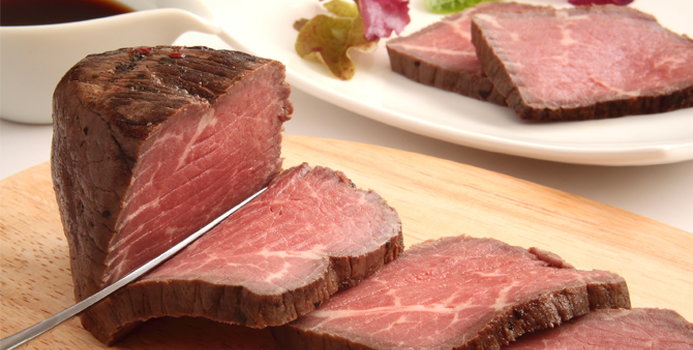Eating too much red meat, especially higher-fat cuts and processed meats, may increase your chronic disease risks. A study published in 2012 in Archives of Internal Medicine found that red meat is associated with higher mortality from heart disease. Much of the fat in red meat is saturated fat, which can increase your blood cholesterol and heart-disease risks, but not all red meat is high in fat. Eating red meat, such as beef, lamb and pork, in moderation and choosing lean cuts helps keep your saturated fat intake and chronic-disease risks low.
High-Fat Meats
Higher-fat red meats are those that contain lots of visible fat marbling. Processed meat and prime grades of red meat are often higher in fat than fresh or frozen select or choice grades. Bacon, sausage, salami, ham and cold cut meats are often high in saturated fat, cholesterol and sodium. Ground beef that is not labeled lean or extra lean is also high in fat. For example, a 3-ounce portion of pan-browned, 70-percent lean, 30-percent fat ground beef contains 15 grams of total fat -- including 6 grams of saturated fat.
Healthier, Lower-Fat Cuts of Meat
The leanest cuts of red meat are those labeled round, loin or sirloin, according to the American Heart Association. Leaner meats also contain less fat marbling. Cutting off visible fat from red meat significantly reduces its fat content. Extra lean ground beef often contains just three percent fat. A 3-ounce portion of pan browned, 97-percent lean, 3-percent fat ground beef contains less than 5 grams of total fat and 2 grams of saturated fat, according to the U.S. Department of Agriculture. However, even the leanest cuts of red meat still contain some saturated fat and cholesterol.
Substitutions for Red Meat
A key nutrient found in red meat is dietary protein. However, you don't have to eat red meat to meet your daily protein needs. In fact, a variety of foods contain almost as much (or more) protein as red meat but with less saturated fat and cholesterol. Examples include skinless chicken, turkey, seafood, egg whites, low-fat cottage cheese, nonfat Greek yogurt, tofu and seitan. Legumes, nuts, seeds, low-fat milk and soy milk are other good sources of dietary protein. Cutting back on red meat, or eliminating it entirely, reduces your risk for developing heart disease, type 2 diabetes and possibly cancer, according to a review published in 2012 in Public Health Nutrition.
Portion Recommendations
While red meat is often higher in fat (particularly saturated fat and cholesterol) than other high-protein alternatives, you can still eat lean red meat in moderation and be healthy. The American Heart Association recommends Americans eat no more than 6 ounces of lean meat, fish or skinless chicken daily. The recommended dietary allowance, or RDA, for fat is 20 to 35 percent of your total calories, which is 44 to 78 grams of total fat when eating 2,000 calories per day. The American Heart Association suggests adults limit saturated fat to less than 7 percent of their caloric intake, or less than 16 grams of saturated fat daily when following a 2,000-calorie meal plan. 
Heart Health: Does Saturated Fat Clog Arteries?
An experienced health, nutrition and fitness writer, Erin Coleman is a registered and licensed dietitian and holds a dietetics degree from the University of Wisconsin-Madison. She also has worked as a clinical dietitian and health educator in outpatient settings. Erin's work is published on popular health websites, such as TheNest.com and JillianMichaels.com



